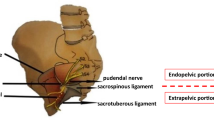Abstract
Objective
Pudendal Nerve Entrapment (PNE) may determine chronic pelvic pain associated with symptoms related to its innervation area. This study aimed to present the technique and report the outcomes of the first series of robot-assisted pudendal nerve release (RPNR).
Patients and methods
32 patients, who were treated with RPNR in our centre between January 2016 and July 2021, were recruited. Following the medial umbilical ligament identification, the space between this ligament and the ipsilateral external iliac pedicle is progressively dissected to identify the obturator nerve. The dissection medial to this nerve identifies the obturator vein and the arcus tendinous of the levator ani, which is cranially inserted into the ischial spine. Following the cold incision of the coccygeous muscle at the level of the spine, the sacrospinous ligament is identified and incised. The pudendal trunk (vessels and nerve) is visualized, freed from the ischial spine and medially transposed.
Results
The Median duration of symptoms was 7 (5, 5–9) years. The median operative time was 74 (65–83) minutes. The median length of stay was 1 (1–2) days. There was only a minor complication. At 3 and 6 months after surgery, a statistically significant pain reduction has been encountered. Furthermore, the Pearson correlation coefficient reported a negative relationship between the duration of pain and the improvement in NPRS score, − 0.81 (p = 0.01).
Conclusions
RPNR is a safe and effective approach for the pain resolution caused by PNE. Timely nerve decompression is suggested to enhance outcomes.

Similar content being viewed by others
References
Luesma MJ, Galé I, Fernando J (2021) Diagnostic and therapeutic algorithm for pudendal nerve entrapment syndrome. Med Clin 157(2):71–78
Pereira A, Pérez-Medina T, Rodríguez-Tapia A, Chiverto Y, Lizarraga S (2018) Correlation between anatomical segments of the pudendal nerve and clinical findings of the patient with pudendal neuralgia. Gynecol Obstet Invest 83:593–599
Engeler D, Baranowski AP, Berghmans B et al (2022) EAU guidelines on chronic pelvic pain
Hibner M, Castellanos ME, Drachman D, Balducci J (2012) Repeat operation for treatment of persistent pudendal nerve entrapment after pudendal neurolysis. J Minim Invasive Gynecol 19(3):325–330
Klifto K, Dellon AL (2020) Persistent genital arousal disorder: treatment by neurolysis of dorsal branch of pudendal nerve. Microsurgery 40(2):160–166
Beco J, Climov D, Bex M (2004) Pudendal nerve decompression in perineology: a case series. BMC Surg 4:15
Erdogru T, Avci E, Akand M (2014) Laparoscopic pudendal nerve decompression and transposition combined with omental flap protection of the nerve (Istanbul technique): technical description and feasibility analysis. Surg Endosc 28(3):925–932
Rey D, Oderda M (2015) The first case of robotic pudendal nerve decompression in pudendal nerve entrapment syndrome. J Laparoendosc Adv Surg Tech A 25(4):319–322. https://doi.org/10.1089/lap.2014.0013
Labat JJ, Riant T, Robert R, Amarenco G, Lefaucheur JP, Rigaud J (2008) Diagnostic criteria for pudendal neuralgia by pudendal nerve entrapment (Nantes criteria). Neurol Urodyn 27:306–310
Clavien PA, Barkun J, de Oliveira ML et al (2009) The Clavien-Dindo classification of surgical complications: five-year experience. Ann Surg 250(2):187–196
Aoun F, Alkassis M, Tayeh GA, Chebel JA, Semaan A, Sarkis J, Mansour R, Mjaess G, Albisinni S, Absil F, Bollens R, Roumeguère T (2021) Sexual dysfunction due to pudendal neuralgia: a systematic review. Transl Androl Urol 10(6):2500–2511
Dellon AL, Coady D, Harris D (2015) Pelvic pain of pudendal nerve origin: surgical outcomes and learning curve lessons. J Reconstr Microsurg 31(4):283–290
Peng PWH, Tumber PS (2008) Ultrasound-guided interventional procedures for patients with chronic pelvic pain—a description of techniques and review of literature. Pain Physician 11(2):215–224
Robert R, Labat JJ, Bensignor M, Glemain P, Deschamps C, Raoul S, Hamel O (2005) Decompression and transposition of the pudendal nerve in pudendal neuralgia: a randomized controlled trial and long-term evaluation. Eur Urol 47(3):403–8
Possover M (2009) Laparoscopic management of endopelvic etiologies of pudendal pain in 134 consecutive patients. J Urol 181(4):1732–1736
Jottard K, Bruyninx L, Bonnet P, Wachter S (2020) A minimally invasive endoscopic transgluteal procedure for pudendal nerve and inferior cluneal nerve neurolysis in case of entrapment: 3-and 6-month results. The ENTRAMI technique for neurolysis. Int J Colorectal Dis 35(2):361–364
Bollens R, Mjaess G, Sarkis J, Chemaly AK, Nemr E, Daher K, Semaan A, Chebel JA, Absil F, Aoun F (2021) Laparoscopic transperitoneal pudendal nerve and artery release for pudendal entrapment syndrome. Surg Endosc 35(11):6031–6038
Author information
Authors and Affiliations
Contributions
All authors have made a significant contribution to the findings and methods in the paper. All authors have read and approved the final draft and consider the manuscript to be honest work.
Corresponding author
Ethics declarations
Disclosures
Carlo Giulioni, Anastasios D. Asimakopoulos, Filippo Annino, Giulia Garelli, Julien Riviere, Julie Piechaud-Kressmann, Nam-Son Vuong, Laurent Hugo Lopez, Jean-Baptiste Roche, Jean Rouffilange, Jean-Luc Hoepffner, Andrea Benedetto Galosi, Richard Pierre Gaston, Thierry Piechaud, Grégory Pierquet have no conflicts of interest or financial ties to disclose.
Additional information
Publisher's Note
Springer Nature remains neutral with regard to jurisdictional claims in published maps and institutional affiliations.
Supplementary Information
Below is the link to the electronic supplementary material.
Supplementary file1 (MP4 172975 kb)
Rights and permissions
Springer Nature or its licensor (e.g. a society or other partner) holds exclusive rights to this article under a publishing agreement with the author(s) or other rightsholder(s); author self-archiving of the accepted manuscript version of this article is solely governed by the terms of such publishing agreement and applicable law.
About this article
Cite this article
Giulioni, C., Asimakopoulos, A.D., Annino, F. et al. First case-series of robot-assisted pudendal nerve release: technique and outcomes. Surg Endosc 37, 5708–5713 (2023). https://doi.org/10.1007/s00464-023-10096-9
Received:
Accepted:
Published:
Issue Date:
DOI: https://doi.org/10.1007/s00464-023-10096-9




